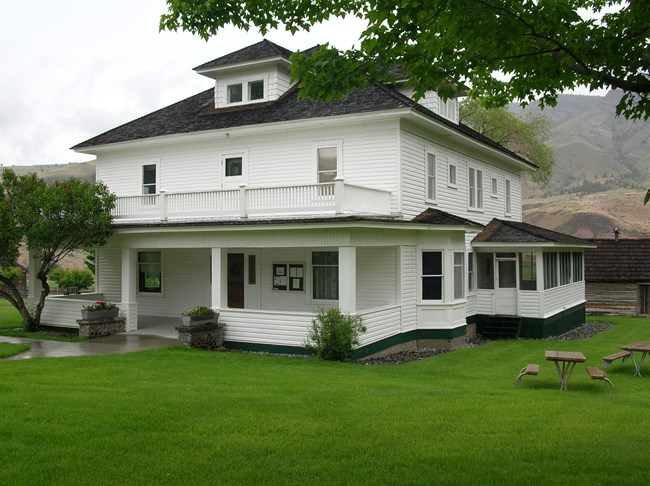Part of a series of articles titled Women's History in the Pacific West - Columbia-Pacific Northwest Collection.
Previous: Margaret Frink
Next: Elizabeth L. Horn
Article

National Park Service photo.
Elizabeth Cant was part of a prominent ranching family who from 1918 to 1973 lived in the ranch house that currently sits on the John Day Fossil Beds National Monument. Drawing on her farming and domestic skills, she journeyed thousands of miles to create a sustainable life for herself and her family.1 Cant’s life sheds light on the communities of Scottish migrants in central Oregon and the shared labor required to sustain them.
Elizabeth Cant was born Elizabeth Grant on November 10, 1885 in Moray County, Scotland.2 She was the youngest child of Mary Grant, who provided for her family by working as a crofter, or tenant farmer, in the Muir of Lochs hamlet just outside of Elgin, Scotland.3 Cant went to school up to her teenage years, when she began working in crofting with her mother.4 At some point, she met James Cant, son of another poor working widow who lived about eighteen miles away in Forres, Scotland.5 In 1900, James left Scotland for Portugal and Argentina, where he worked for sheep stockers buying merino sheep and created a business of his own selling mules. Eventually he settled in central Oregon, and in 1907 Elizabeth Cant left Scotland to join him there, marrying him in October 1908.6
For the first few years of their marriage, the Cants worked for another Scottish rancher, Alexander Murray, with Elizabeth working as a cook.7 When they earned enough money and sheep from the Murrays, James Cant bought land that was then called the Officer Homestead with a business partner. The family moved in and began to raise sheep, chickens, and bees, grow a garden, and plant crops such as alfalfa and barley.8 By 1917, the Cants had four children, were regularly hosting travelers making their way to and from The Dalles, and were providing boarding for multiple sheepherders who worked on the Cant property. In order to accommodate the large amount of people, the Cants built a larger house with two and a half stories that still stands today.9
Cant continued to cultivate the garden, cook, and oversee the household as the ranch grew in size and prominence. She boarded the first schoolteacher in the area, Stella Pigg, and allowed the third floor of her house to be used as the region’s first school.10 When workers came to the area to build a highway, she hosted them while they worked and hired them for a few irrigation projects on her own ranch, showing her involvement both in the development of the community and her own family business.11
Cant also used her house as a social center. She hosted multiple gatherings with food and dancing for neighbors and their children on the third floor of her house. The large Scottish community in the area were often in the Cant home for parties with Scottish music and dress. The Cant family was also famous for their midnight suppers that could have more than twenty guests and last until the morning.12 This socializing was extremely important in the isolated valley where neighbors were often dozens of miles apart. By providing a space for that socializing, the Cants increased morale and a sense of community among geographically distant people.
Throughout the 1920s and 1930s the Cant ranch was successful, with hundreds of head of sheep, thousands of acres of land, and dozens of employees and boarders. The family planted apple and peach orchards, and Cant made sure to plant essential shade trees to cool the house and yard in the hot, arid climate.13 In the 1940s, when sheep became unprofitable, the Cants transitioned to cattle raising and continued to run an extremely lucrative ranch throughout the 1950s and 1960s, with the assistance of their grown children and their spouses.14 In 1972 James Cant died, followed a year later by Elizabeth Cant on May 15, 1973.15 Two years later, the family sold the ranch to the National Park Service. Elizabeth Cant’s home became the headquarters and visitor center for the John Day Fossil Beds National Monument, where it continued to serve the purpose that Cants had made it serve—as a hospitable center for people to come together in an isolated and beautiful place.
Part of a series of articles titled Women's History in the Pacific West - Columbia-Pacific Northwest Collection.
Previous: Margaret Frink
Next: Elizabeth L. Horn
Last updated: December 5, 2022